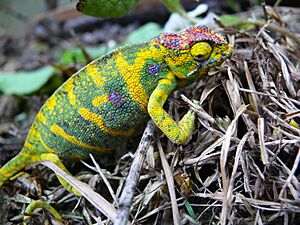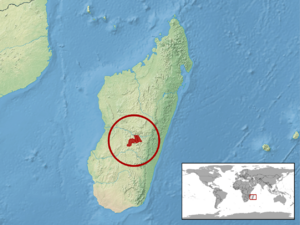Lesser chameleon facts for kids
Quick facts for kids Lesser chameleon |
|
|---|---|
 |
|
| Male | |
 |
|
| Female | |
| Conservation status | |
| Scientific classification | |
| Genus: |
Furcifer
|
| Species: |
minor
|
 |
|
The lesser chameleon (Furcifer minor) is a special kind of lizard that belongs to the Chamaeleonidae family. It is also known as the minor chameleon. This amazing creature is found only in Madagascar, which means it is endemic there.
Contents
All About the Lesser Chameleon
The lesser chameleon lives in dry, tree-filled places, often with grassy areas nearby. These chameleons usually live by themselves and can be quite aggressive towards other chameleons of their own kind. They are clever hunters, catching food whenever they get the chance.
One cool thing about lesser chameleons is that the female is usually more colorful than the male! When a female is pregnant, she shows off bright greenish-black and yellow stripes, with yellow spots on darker areas. She also has blue-violet and red-black spots on her chest, and her lower jaw is red. When she's resting, she has yellowish stripes.
Males are mostly shades of brown, black, white, and reddish-orange. But when they want to show off, they can change to a darker black and white striped pattern. The most noticeable thing about the male is a horn-like growth that sticks out from the end of his nose. Males can grow up to about 24 centimeters (about 9.4 inches) long, while females are a bit smaller, usually around 16 centimeters (about 6.3 inches).
Where Lesser Chameleons Live
Lesser chameleons mostly live in forests where a special tree called Uapaca bojeri grows. These forests are often called tapia forests. They also live in other unique places, like humid mountain areas, between 1,000 and 1,650 meters (about 3,280 to 5,413 feet) above sea level in Madagascar.
Sometimes, these chameleons can also be found in pasturelands, and even on coffee and cocoa plantations. They might even be more common in these farmed areas. Sadly, the places where they live have been broken up by large areas of grassland that aren't suitable for them.
Lesser Chameleon Population
In areas where their habitat is healthy and not disturbed, lesser chameleons are quite common. Scientists have found about 16.4 chameleons per hectare (about 2.47 acres) in these undisturbed regions.
Lesser Chameleon Life Cycle
Lesser chameleons are oviparous, which means they lay eggs. A female can lay between 4 and 16 eggs in one group, called a clutch. In captivity, some females have laid as many as 3 clutches in a year, but usually, it's closer to 1 clutch per year.
One female chameleon was found to have 12 eggs inside her, each about 12 by 7 millimeters (about 0.47 by 0.28 inches). These eggs need to stay at a steady temperature of 23 degrees Celsius (about 73 degrees Fahrenheit) for 8 to 9 months before they hatch. Young chameleons usually become old enough to have their own babies when they are between 5 and 8 months old.
After a female chameleon has found a mate, her colors will change, and she will become very aggressive towards males. It takes about 2 to 3 months for the eggs to develop inside her. Sometimes, a female chameleon might even die during her first time laying eggs if there are problems.
Protecting Lesser Chameleons
The lesser chameleon is facing threats because its home is being destroyed. This habitat loss happens because of mining for quartz and tourmaline, cutting down trees (logging), and clearing land using slash-and-burn methods for farming.
Even though their habitat is being lost, there are signs that these chameleons can adapt to new places. However, we don't have enough information about their lives to know if these new places are good enough for them to have babies. People also collect these chameleons in the Itremo region, but this is usually done in small amounts and is not thought to be a big threat to the chameleon population.
In 1994, an organization called CITES reported that over 1,200 lesser chameleons were sent from Madagascar to be sold as pets in Western countries. Because of this, it was banned to export them from Madagascar that same year. The lesser chameleon is now listed in Appendix II of CITES, which means there are rules about trading this species to protect it. Part of the area where they live in Itremo is also in the process of becoming a protected area.


